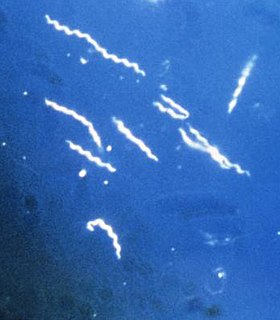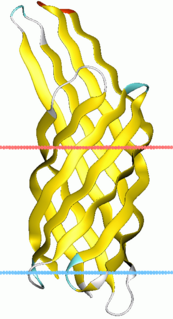
A spirochaete or spirochete is a member of the phylum Spirochaetes, which contains distinctive diderm (double-membrane) gram-negative bacteria, most of which have long, helically coiled cells. Spirochaetes are chemoheterotrophic in nature, with lengths between 3 and 500 μm and diameters around 0.09 to at least 3 μm.

Lyme disease, also known as Lyme borreliosis, is a vector-borne disease caused by the Borrelia bacterium which is spread by ticks in the genus Ixodes. The most common sign of infection is an expanding red rash, known as erythema migrans, that appears at the site of the tick bite about a week after it occurred. The rash is typically neither itchy nor painful. Approximately 70–80% of infected people develop a rash. Early diagnosis can be difficult. Other early symptoms may include fever, headache, and tiredness. If untreated, symptoms may include loss of the ability to move one or both sides of the face, joint pains, severe headaches with neck stiffness, or heart palpitations, among others. Months to years later, repeated episodes of joint pain and swelling may occur. Occasionally, people develop shooting pains or tingling in their arms and legs. Despite appropriate treatment, about 10 to 20% of people develop joint pains, memory problems, and tiredness for at least six months.
Tick-borne diseases, which afflict humans and other animals, are caused by infectious agents transmitted by tick bites. They are caused by infection with a variety of pathogens, including rickettsia and other types of bacteria, viruses, and protozoa. Because individual ticks can harbor more than one disease-causing agent, patients can be infected with more than one pathogen at the same time, compounding the difficulty in diagnosis and treatment. 16 tick-borne diseases of humans are known, of which four have been discovered since 2013.

Borrelia burgdorferi sensu stricto is a bacterial species of the spirochete class in the genus Borrelia, and is one of the causative agents of Lyme disease in humans. Along with a few similar genospecies, some of which also cause Lyme disease, it makes up the species complex of Borrelia burgdorferi sensu lato. The complex currently comprises 20 accepted and 3 proposed genospecies. B. burgdorferi sensu stricto exists in North America and Eurasia and until 2016 was the only known cause of Lyme disease in North America. Borrelia species are gram-negative.

The white-footed mouse is a rodent native to North America from Ontario, Quebec, Labrador, and the Maritime Provinces to the southwestern United States and Mexico. In the Maritimes, its only location is a disjunct population in southern Nova Scotia. It is also known as the woodmouse, particularly in Texas.

Borrelia is a genus of bacteria of the spirochete phylum. It causes Lyme disease, also called Lyme borreliosis, a zoonotic, vector-borne disease transmitted primarily by ticks and by lice, depending on the species of bacteria. The genus is named after French biologist Amédée Borrel (1867–1936), who first documented the distinction between a species of Borrelia, B. anserina, and the other known type of spirochete at the time, Treponema pallidum. This bacterium must be viewed using dark-field microscopy, which make the cells appear white against a dark background. Borrelia species are grown in Barbour-Stoenner-Kelly medium. Of 52 known species of Borrelia, 20 are members of the Lyme disease group, 29 belong to the relapsing fever group, and two are members of a genetically distinct third group typically found in reptiles. The Lyme disease group has been proposed to be split based on genetic diversity and moved to their own genus, Borelliella, but this change is not widely accepted. This bacterium uses hard and soft ticks and lice as vectors. Testing for the presence of the bacteria in a human includes two-tiered serological testing, including immunoassays and immunoblotting.

Lyme disease, or borreliosis, is caused by spirochetal bacteria from the genus Borrelia, which has 52 known species. Three main species are the main causative agents of the disease in humans, while a number of others have been implicated as possibly pathogenic. Borrelia species in the species complex known to cause Lyme disease are collectively called Borrelia burgdorferisensu lato (s.l.) not to be confused with the single species in that complex Borrelia burgdorferi sensu stricto which is responsible for nearly all cases of Lyme disease in North America.

Ixodes scapularis is commonly known as the deer tick or black-legged tick, and in some parts of the US as the bear tick. It is a hard-bodied tick found in the eastern and northern Midwest of the United States as well as in southeastern Canada. It is a vector for several diseases of animals, including humans and is known as the deer tick owing to its habit of parasitizing the white-tailed deer. It is also known to parasitize mice, lizards, migratory birds, etc. especially while the tick is in the larval or nymphal stage.
Allen Caruthers Steere is a professor of rheumatology at Harvard University and previously at Tufts University and Yale University. Steere and his mentor, Stephen Malawista of Yale University, are credited with discovering and naming Lyme disease, and he has published almost 300 scholarly articles on Lyme disease during his more than 40 years of studies of this infection. At a ceremony in Hartford, Connecticut in 1998, Governor John G. Rowland declared September 24 to be "Allen C. Steere Day."

Virulence-related outer membrane proteins are expressed in the outer membrane of gram-negative bacteria and are essential to bacterial survival within macrophages and for eukaryotic cell invasion.

Southern tick-associated rash illness (STARI) is an emerging infectious disease related to Lyme disease that occurs in southeastern and south-central United States. It is spread by tick bites and it was hypothesized that the illness was caused by the bacteria Borrelia lonestari. However, there is insufficient evidence to declare this Borrelia strain as a causative agent.

Human granulocytic anaplasmosis (HGA) is a tick-borne, infectious disease caused by Anaplasma phagocytophilum, an obligate intracellular bacterium that is typically transmitted to humans by ticks of the Ixodes ricinus species complex, including Ixodes scapularis and Ixodes pacificus in North America. These ticks also transmit Lyme disease and other tick-borne diseases.
Borrelia lusitaniae is a bacterium of the spirochete class of the genus Borrelia, which has a diderm (double-membrane) envelope. It is a part of the Borrelia burgdorferisensu lato genospecies and is a Gram-negative bacterium. B. lusitaniae is tick-borne; he type strain is PotiB2. It can be pathogenic, being involved in cases of Lyme borreliosis. A species of tick, Ixodes ricinus, is the host of B. lusitaniae. It is thought to have originated from Portugal and has since spread to parts of Europe and North Africa. Lizards of the family Lacertidae are now believed to be important reservoir hosts of this bacterium.
Borrelia valaisiana is a spirochaete bacterium; strain VS116 is the type strain. It is a potential pathogen.
Borrelia bissettiae is a spirochete bacterium. The type strain is strain DN127. It is pathogenic and causes Lyme borreliosis in the Americas and Eurasia.
Borrelia kurtenbachii is a spirochete bacterium; it can be pathogenic, being involved in cases of Lyme borreliosis.
Borrelia sinica is a spirochete bacterium. Its cells contain only four periplasmic flagella inserted at each end of the spirochaetes, differing from other Borrelia species. It is associated with Lyme disease. CMN3T is the type strain of this species.
Borrelia carolinensis is a spirochete bacterium associated with Lyme disease.
Rickettsia monacensis is a tick-borne spotted fever group Rickettsia species.
Borrelia mayonii is a Gram-negative, host-associated spirochete that is capable of causing Lyme disease. This organism can infect various vertebrate and invertebrate hosts such as humans and ticks, primarily Ixodes scapularis. Migratory songbirds play a role in the dispersal of the tick vector, Ixodes scapularis, across long distances, indirectly dispersing Borrelia mayonii as well.







